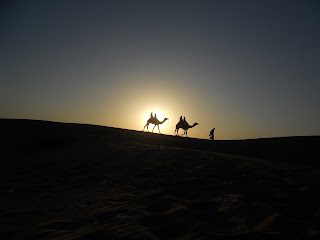Wow, where has the time gone?! When I prepared to leave for India, it seemed that study abroad would last for a very long time. Now, just a few months later, I wonder how it all went so quickly! That's right: I leave tomorrow for Minnesota. I visited a few last sites. I ate some last-minute favorite foods. My bags are filled with souvenirs and waiting to go to the airport in the morning. It all seems so surreal that I do not even know how to approach going home.
During the past few months, I have fallen in love with Kolkata. It may be dirty and noisy, but it is unquestionably the most vibrant place I have ever experienced. And I don't just say this because Indian people have a knack for wearing colors and patterns that most Americans and Europeans would avoid at all costs (and look great wearing these items). There is a real, unique life in the city. It's so...well...I cannot even describe it. All I know is that Kolkata has become another home. Minnesota will always be my favorite place in the world, but I feel like I could easily experience the "coming home" feeling if (when) I visit Kolkata again in the future. People are incredibly friendly, from curious gawkers staring at foreigners to taxi drivers who speak almost no English but can name our president to the wonderful friends I have made. My friends and host parents have insisted that I find some reason to return to their city sooner rather than later. It may be later than they wish, but I hope to see them and their unbelievable city again someday.
As with any experience, not everything has been perfect. Some experiences brought frustrations, and I was unable to visit all of the many places I dream of traveling (next trip?). Moreover, I experienced a variety of unforeseen challenges as we worked out the kinks of this first ever CSB/SJU semester-long study abroad program in India. However, I return home without regrets. I have seen and experienced things that I would have never imagined. I have also learned and grown such that I am not the same person who left Minnesota in December. And I cannot wait to use what I learned in India to be the best teacher and the best person that I can possibly be. India has been absolutely phenomenal. I refuse to say more than just a temporary goodbye.
In other news, I may be leaving India, but I do not wish to leave this blog...for now at least. I have more pictures and videos to share. More importantly, I hope to share more reflections once I return home relating to readjusting to Minnesota and the new perspectives I gain on India after my return. Don't worry, I'm not going away yet!
During the past few months, I have fallen in love with Kolkata. It may be dirty and noisy, but it is unquestionably the most vibrant place I have ever experienced. And I don't just say this because Indian people have a knack for wearing colors and patterns that most Americans and Europeans would avoid at all costs (and look great wearing these items). There is a real, unique life in the city. It's so...well...I cannot even describe it. All I know is that Kolkata has become another home. Minnesota will always be my favorite place in the world, but I feel like I could easily experience the "coming home" feeling if (when) I visit Kolkata again in the future. People are incredibly friendly, from curious gawkers staring at foreigners to taxi drivers who speak almost no English but can name our president to the wonderful friends I have made. My friends and host parents have insisted that I find some reason to return to their city sooner rather than later. It may be later than they wish, but I hope to see them and their unbelievable city again someday.
As with any experience, not everything has been perfect. Some experiences brought frustrations, and I was unable to visit all of the many places I dream of traveling (next trip?). Moreover, I experienced a variety of unforeseen challenges as we worked out the kinks of this first ever CSB/SJU semester-long study abroad program in India. However, I return home without regrets. I have seen and experienced things that I would have never imagined. I have also learned and grown such that I am not the same person who left Minnesota in December. And I cannot wait to use what I learned in India to be the best teacher and the best person that I can possibly be. India has been absolutely phenomenal. I refuse to say more than just a temporary goodbye.
In other news, I may be leaving India, but I do not wish to leave this blog...for now at least. I have more pictures and videos to share. More importantly, I hope to share more reflections once I return home relating to readjusting to Minnesota and the new perspectives I gain on India after my return. Don't worry, I'm not going away yet!















